NIKKEI The STYLE
戸田工務店が初めて日本経済新聞に、紹介されました。 空き ...もっとみる
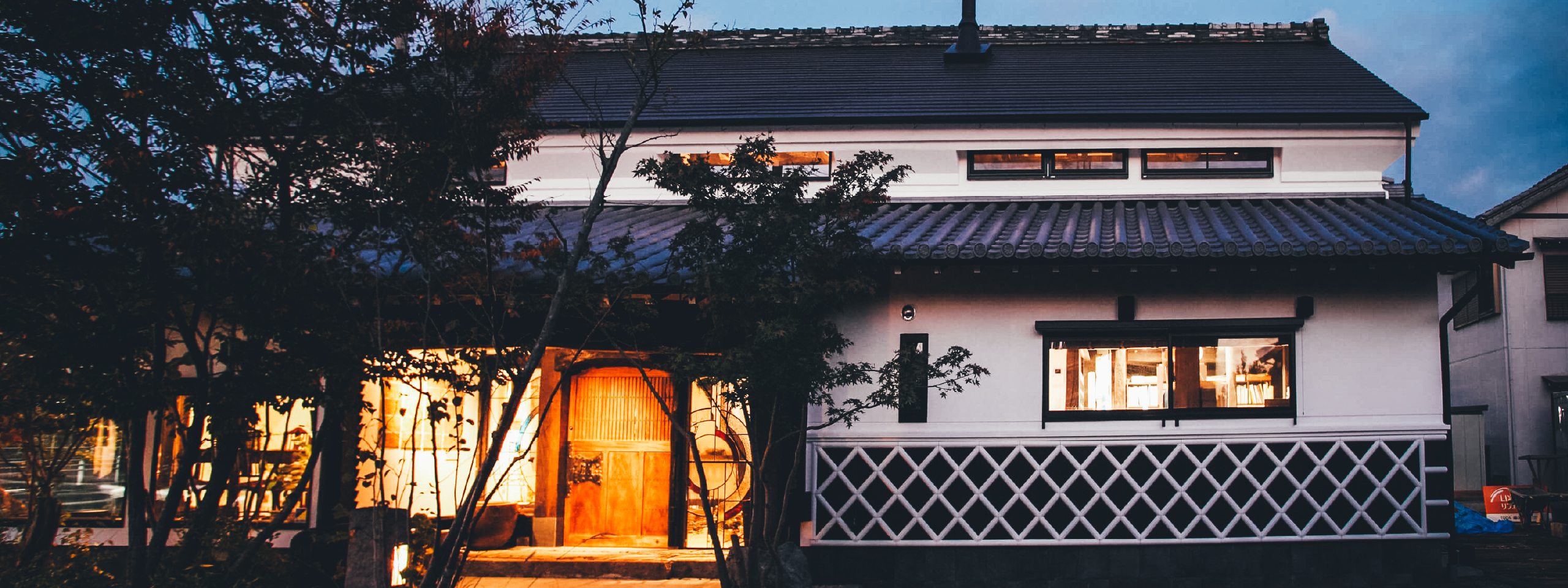
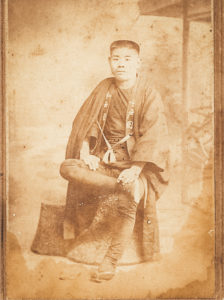
Toda Komuten is an architectural design and construction company based in the Okumikawa region, a strikingly beautiful mountainous area on the eastern edge of Aichi Prefecture in the center of the Japanese archipelago. Our company is located not far from where Toyota Motor Corporation is headquartered, an area rich in tradition and, due to being heavily forested, well known for beautiful wood products produced by skilled craftspeople.
The origins of the Toda Komuten date back to the Taisho era in the 1910s when the great-grandfather of the current president began working as a carpenter and later, following in his father’s footsteps, his son Shinichiro also worked as a carpenter and started Toda Komuten as a design-build construction company in 1960. The tradition continued as Yoshinobu Toda, Shinichiro’s son, studied and trained in design in Osaka and then returned to the company to be in charge of design.
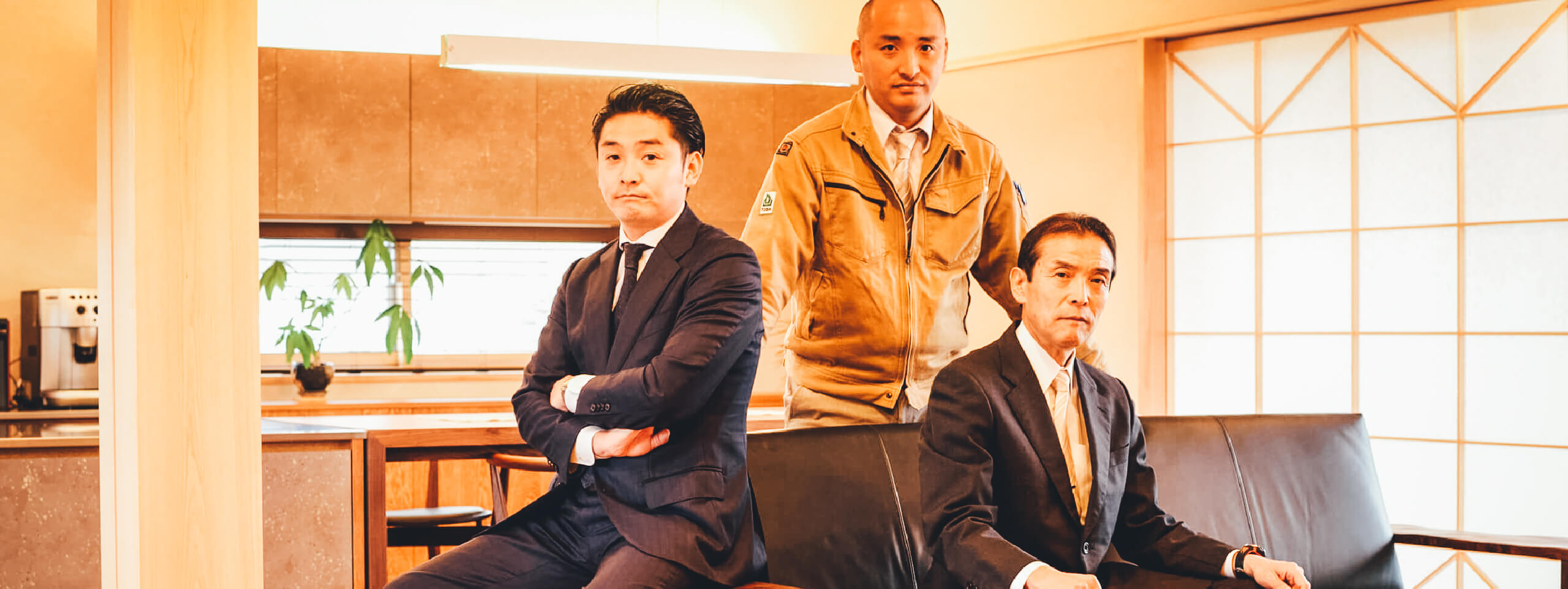
Yoshinobu Toda’s older son, Keiichiro, then studied and trained in design in Nagoya before joining the company in 2002. He was initially engaged in design, sales, and public relations, and in 2017 assumed the position of Representative Director, a position he holds to this day. In 2016, Koji, the younger brother of the current president, returned to Toda Komuten from his apprenticeship and is now running the company together with his brother and father.
Their work includes new construction of wooden houses and commercial buildings, as well as reconstructing and remodeling old houses and other structures.
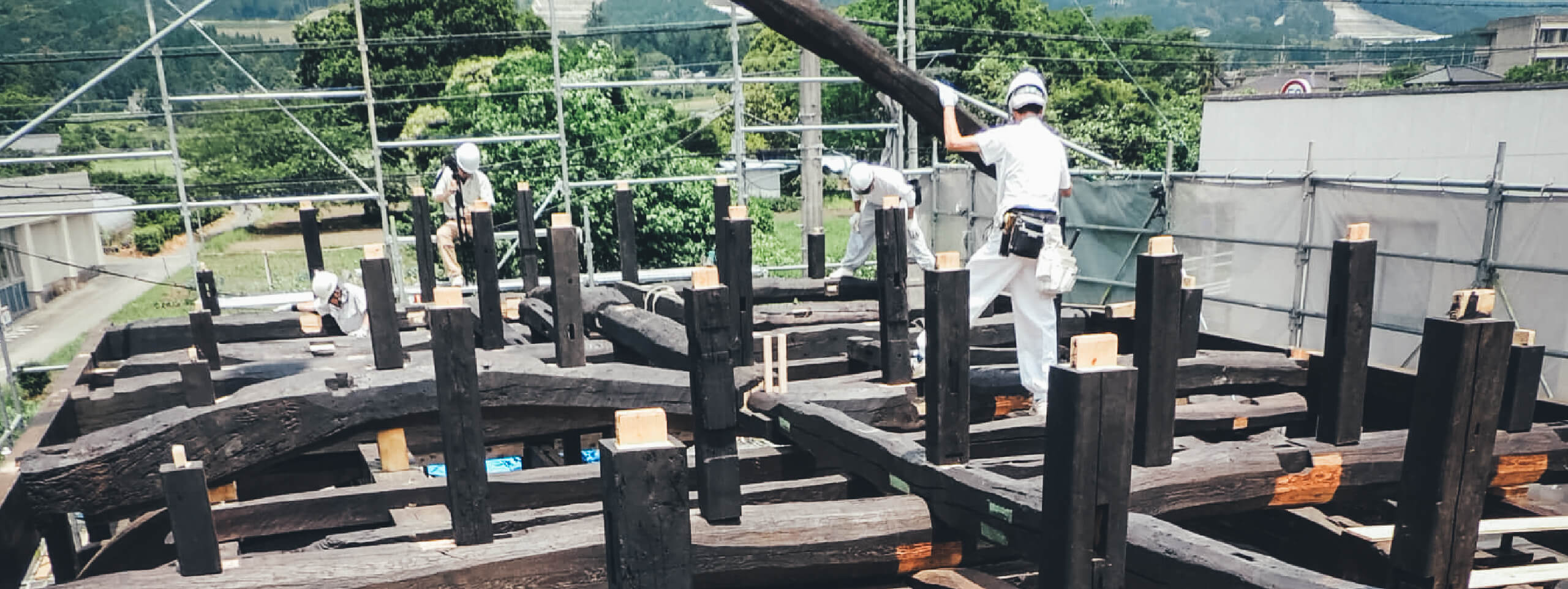
The Japanese housing construction industry has become more and more automated and the pre-cutting method, in which the structural frame of a building is processed by machines, has become mainstream. At the same time, Japanese folk houses are being torn down and traditional building techniques are in danger of being lost.
In response to this, Yoshinobu Toda established the Aichi Prefecture Kominka Association in 2010. As the organization’s secretariat, he works with colleagues across Japan to share Japanese folk house culture and pass on traditional Japanese carpentry skills through the restoration of old houses. The organization also works to revitalize the local economy through the restoration of traditional folk houses.
Through these efforts, Yoshinobu Toda began to focus on the restoration of the many remaining kominka in the Okumikawa region, and in the process came to appreciate again that the knowledge and experience of a carpenter skilled in traditional building techniques is essential to renovating old houses. For this reason, we also began to focus on training young carpenters in order to pass on to future generations the traditional building skills that are the origin of Toda Komuten.
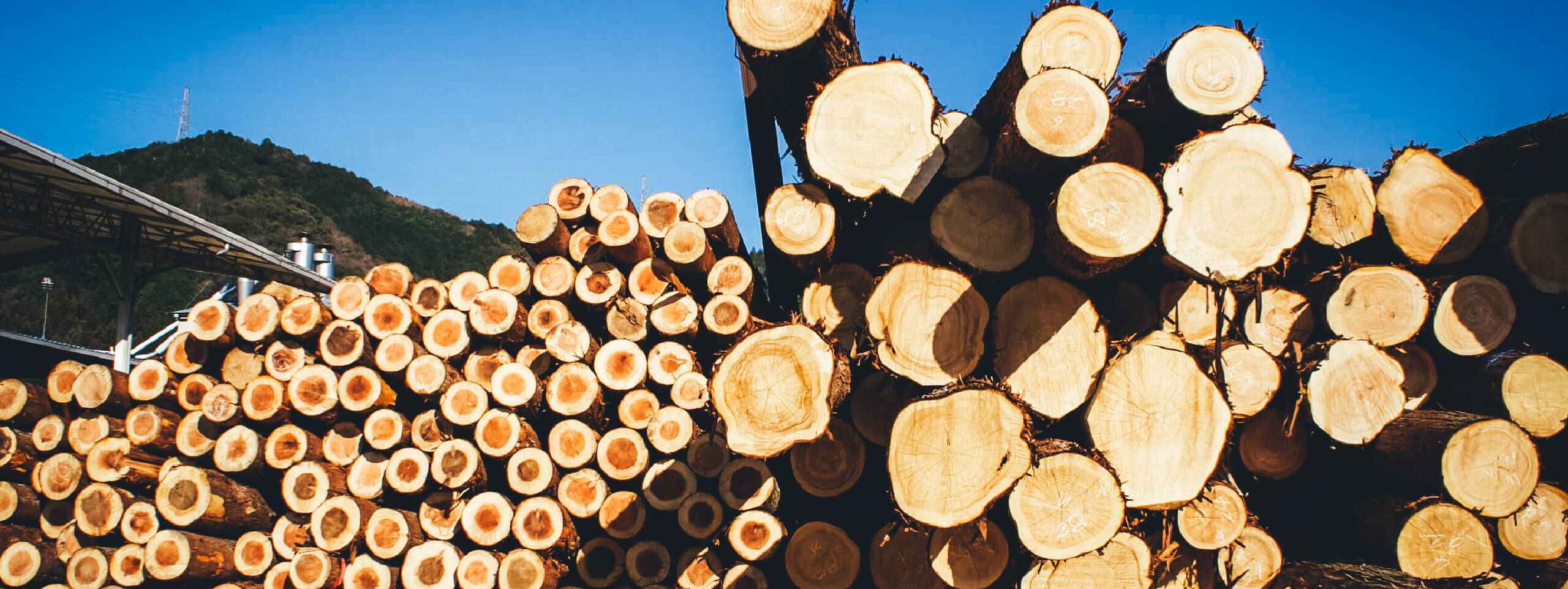
As we began to focus on passing on traditional carpentry skills, we also came to pay more attention to the wood used for building houses.
The current situation in Japan is that for the sake of efficiency wood is dried artificially by being put into a drying kiln in order to remove the moisture from the inside of the wood in a shorter period of time. However, in the days when there were no drying kilns, after the lumber was cut it was dried naturally little by little with the help of the sun and wind over a long period of time.
Unlike natural drying, artificial drying forcibly removes the moisture from the wood, which means that not only the moisture inside the wood but also the fatty components are removed, resulting in the loss of the wood’s original color, luster, and aroma. And, when you actually chisel the wood, the difference between artificially dried wood and naturally dried wood is completely different in terms of stickiness, and this difference is very obvious to skilled carpenters.
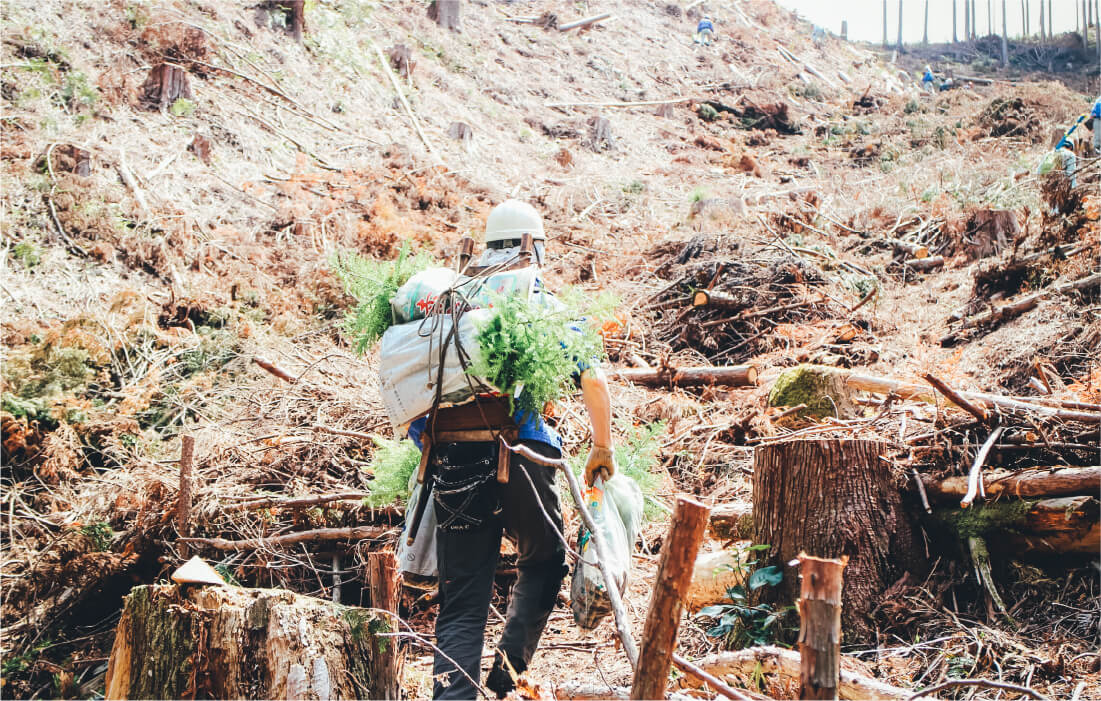
When our ancestors were working as carpenters, there were no drying kilns, and all the wood they handled must have been natural dried wood, and therefore almost all the materials used in old houses must have been naturally dried. Because we would like our new houses to have these same extraordinary qualities as those of traditional kominka we decided in 2010 to use only naturally dried wood.At the same time, we became more and more interested in mountains as a place where lumber is produced. Unlike precious virgin forests, mountains where cedar and cypress are used for lumber production need to be maintained in a cycle of planting, clearing underbrush, pruning, thinning, and felling.
It takes 50 to 60 years at the earliest from planting to felling, and the Japanese forestry industry is a long-term business that can be likened to ‘parents plant, their children grow, their grandchildren reap, and repeat’. This is an area that even people in the industry rarely venture into, but we believe that it is very important to learn about the harshness of on-site work in the mountains by observing actual tree planting, underbrush cutting, and felling, and to understand the process by which trees are cut down and turned into products. We believe that it is very important to know how trees are harvested and how they are processed into products.
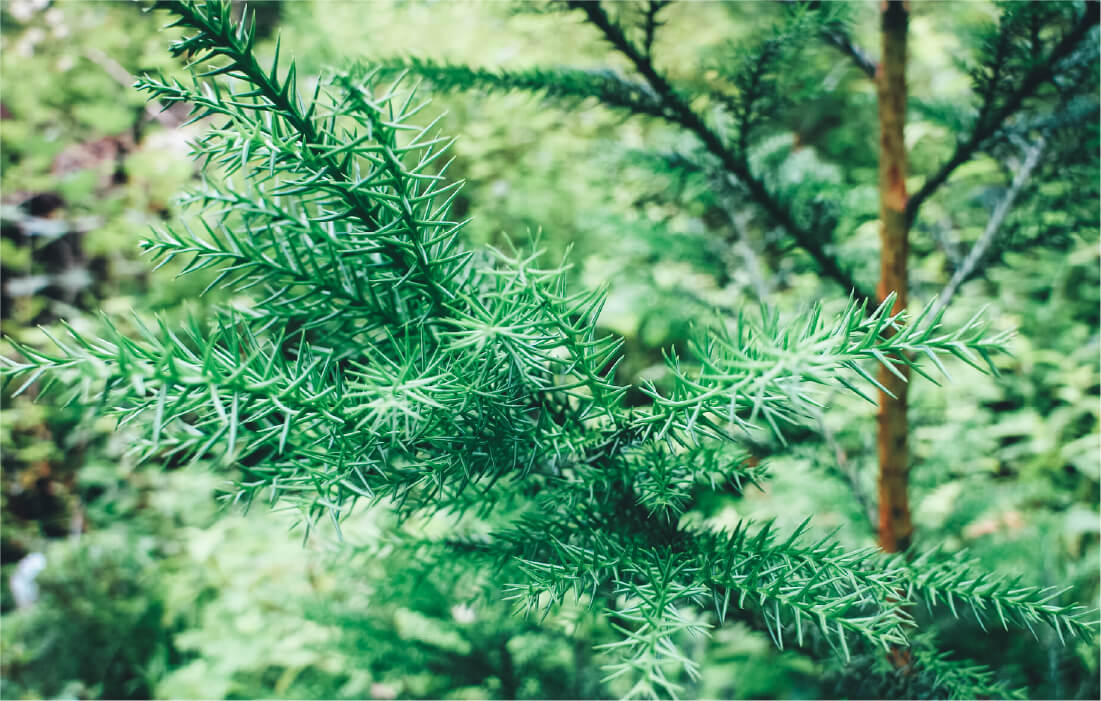
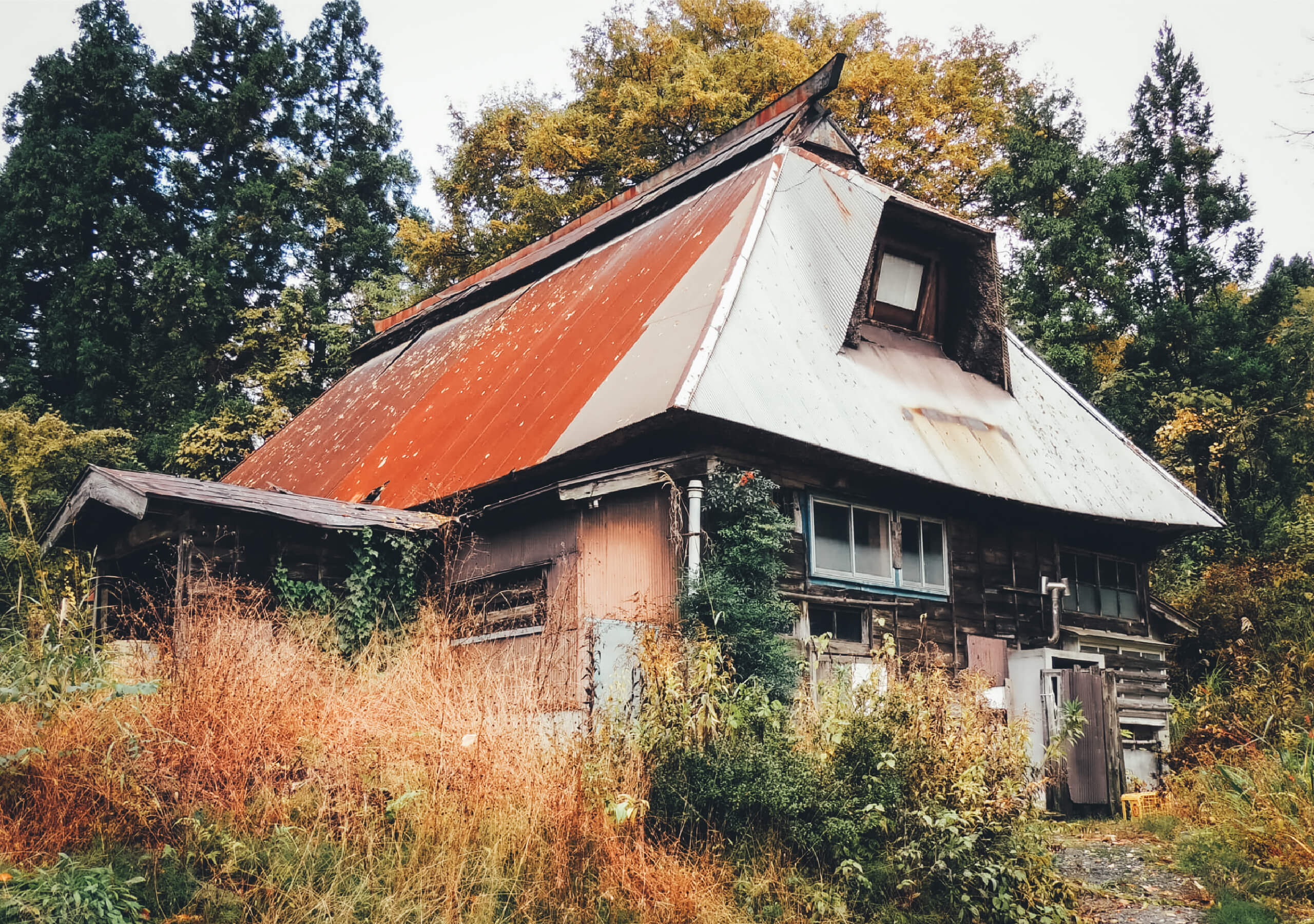
Recently, we have been working on the “vacant house problem”, which can be said to be an issue for all of Japan’s regional cities.
The NPO Okumikawa Rural Life Team, led by Yoshinobu Toda as president, has sought – with rather limited success – to match people from the cities who want to live in rural areas with old houses in the countryside. In the midst of these efforts, we became involved in a project to relocate the frame of an old kominka that the owner liked from the countryside to rebuild the interior and construct a new house to comply with current laws. The experience gained from this project was then very useful when we relocated old kominka from Echigo in Niigata Prefecture and reconstructed it for use as our company’s head office.
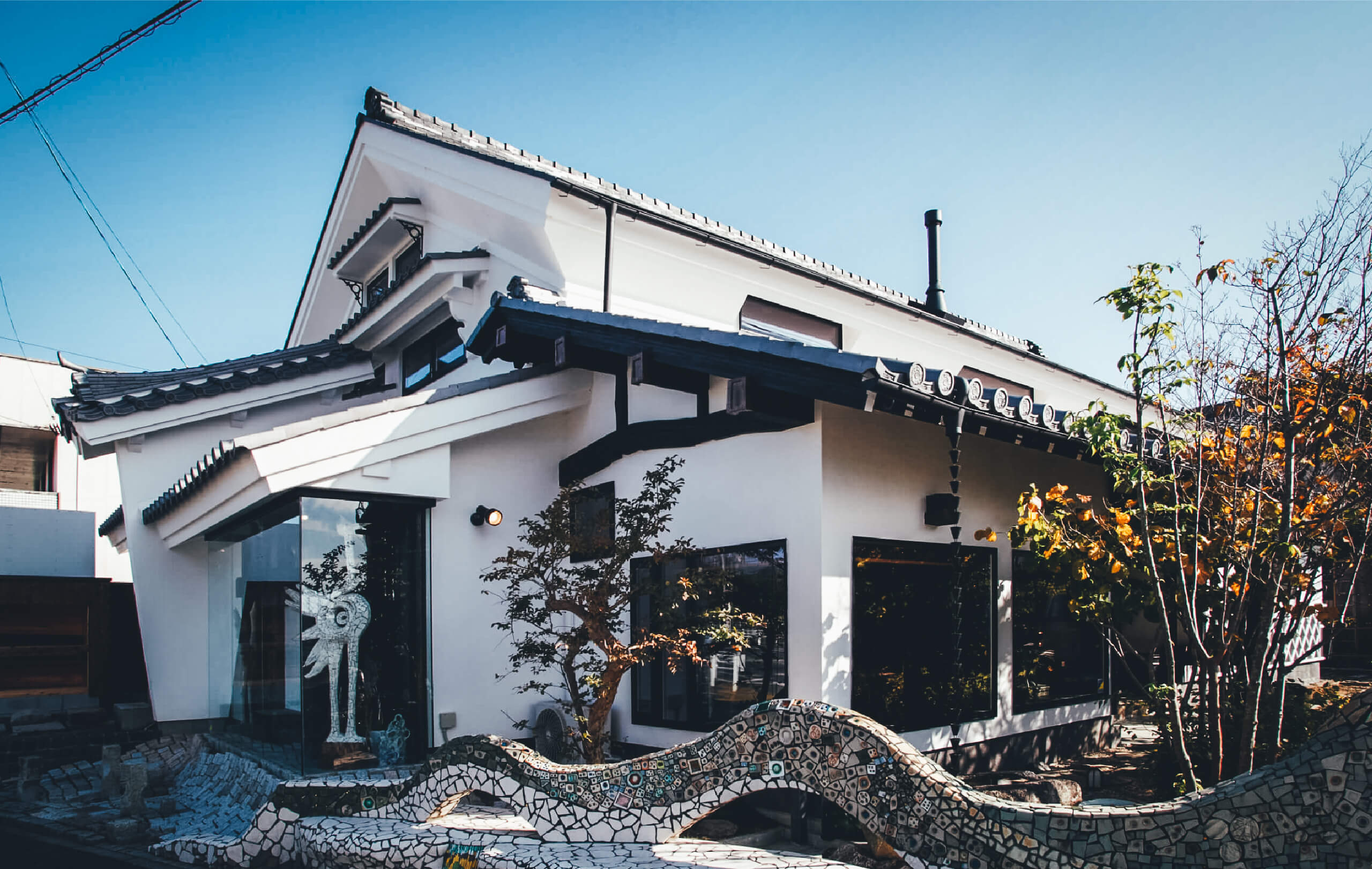
The activities described above have been recognized by the government, and the Aichi Kominka Association signed a comprehensive agreement with the four municipalities of Okumikawa (Shinshiro City, Shitara Town, Toei Town, and Toyone Village) for the use of vacant and other kominka from March to October 2020.
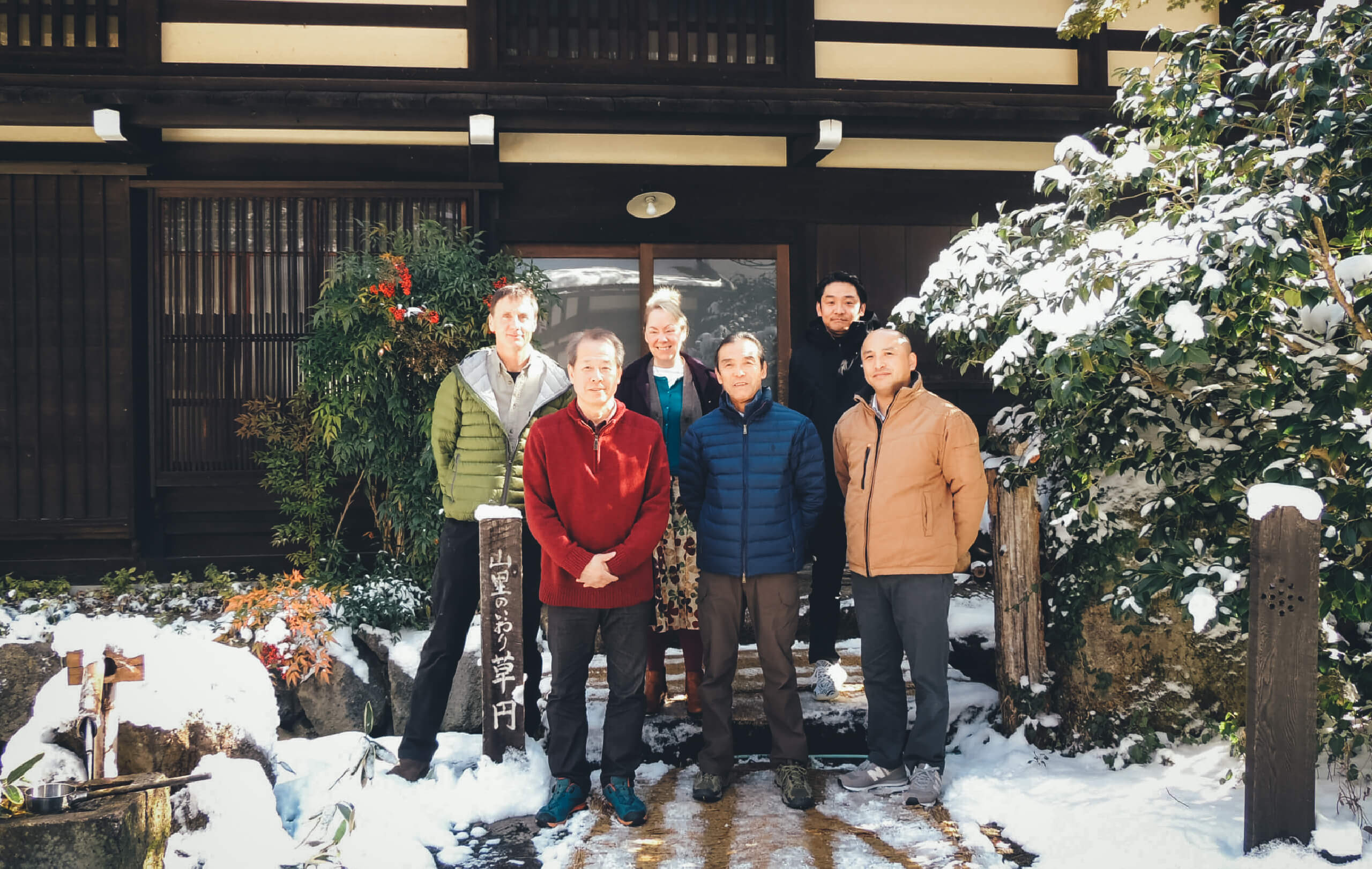
It was around this time that we met Eric Carlson and Kunito Niwa through a member of the Aichi Prefecture Kominka Association. Eric is an architectural designer living in Oregon who has admired and studied Japanese traditional carpentry for many years. His brother-in-law, Kunito Niwa, has lived for many years overseas and also has a deep interest in Japanese architecture. In January 2020, just before the Covid-19 pandemic, Eric came to Aichi Prefecture to look into relocating a kominka to the United States.
While searching for kominka in Japan, Eric and Kunito came across the Aichi Kominka Association and were introduced to Toda Komuten. They visited our head office, and the fact that the building is a relocated kominka matched what they wanted to do and a friendship was formed.
As fate would have it, around that time there was a vacant kominka that was destined to be demolished and as it was a good opportunity, we went to see the house. The size and decor of the kominka matched what Eric had imagined, and we decided to move the house to Oregon, although we were still not sure if and how we could do so at that point. We called this joint endeavor the ‘Kominka Collective Project’.
In the midst of all this, the pandemic was becoming increasingly severe, and Eric left Japan in March
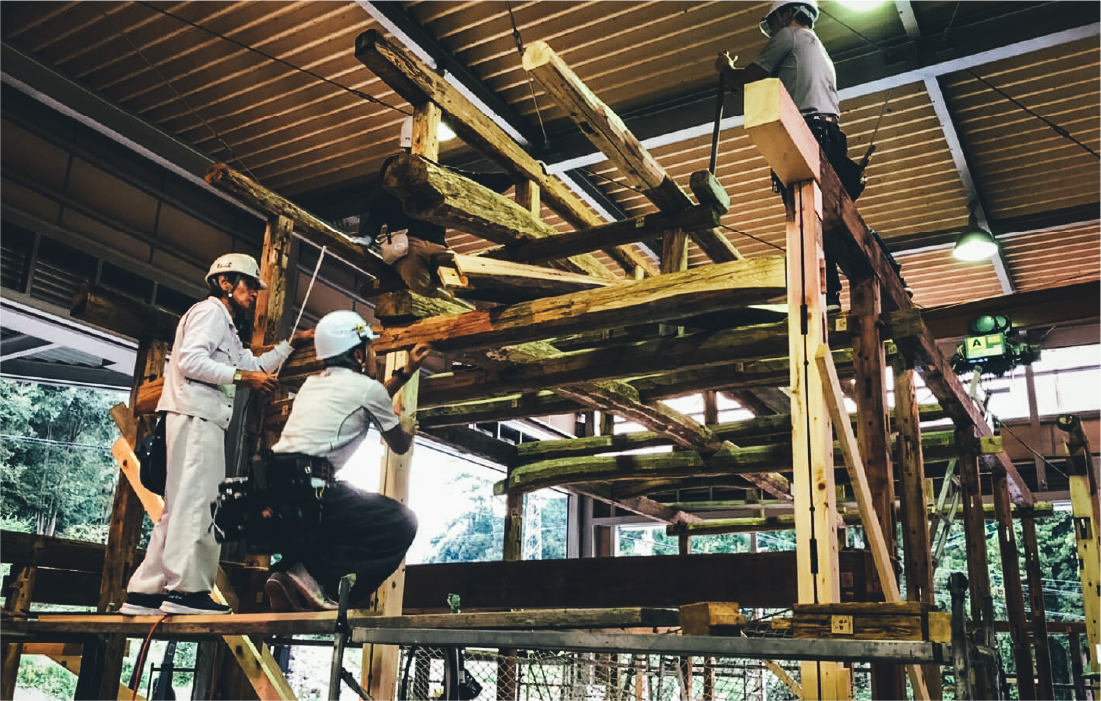
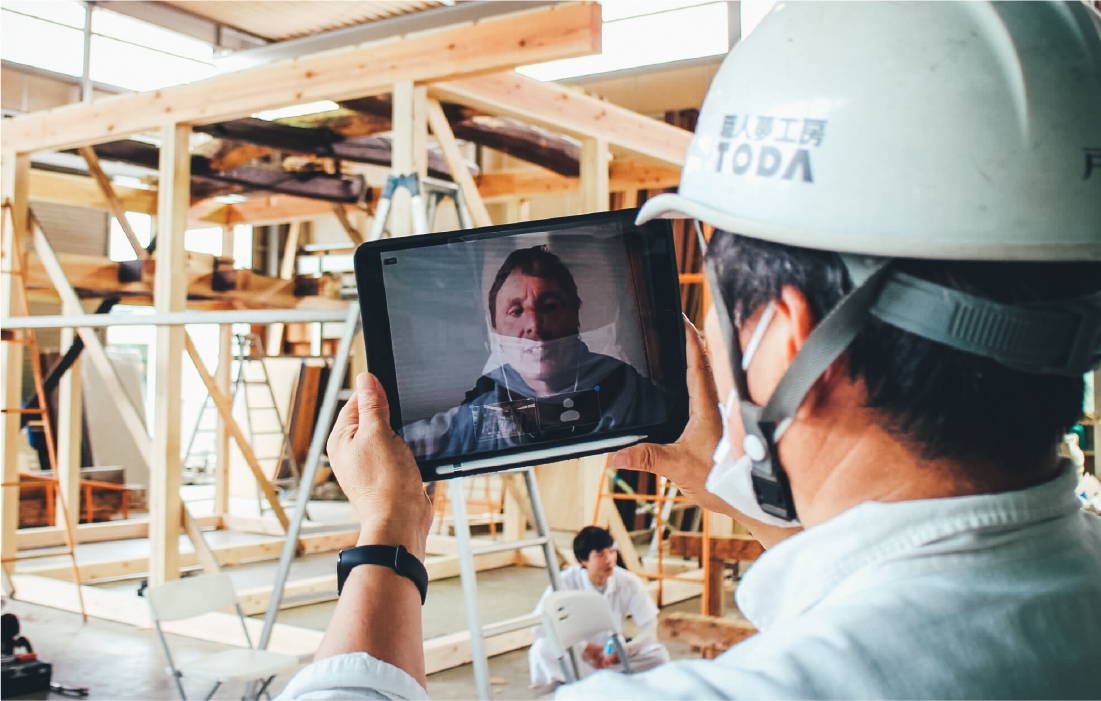
We decided not to be intimidated by the situation and steadily proceeded with the project. Since it was not possible for the U.S. side and the Japan side to meet in person in either country, we had many meetings online and together cleared various hurdles, such as learning about local laws and regulations, shipping arrangements, trade procedures, dismantling, and assembly methods, among others.
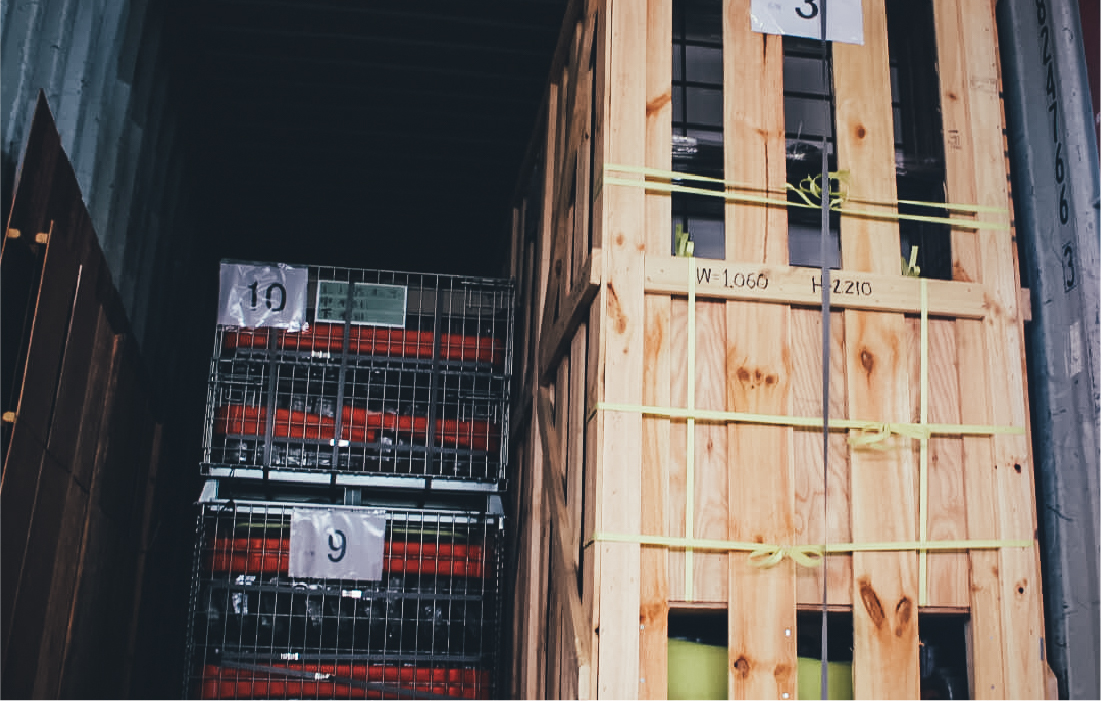
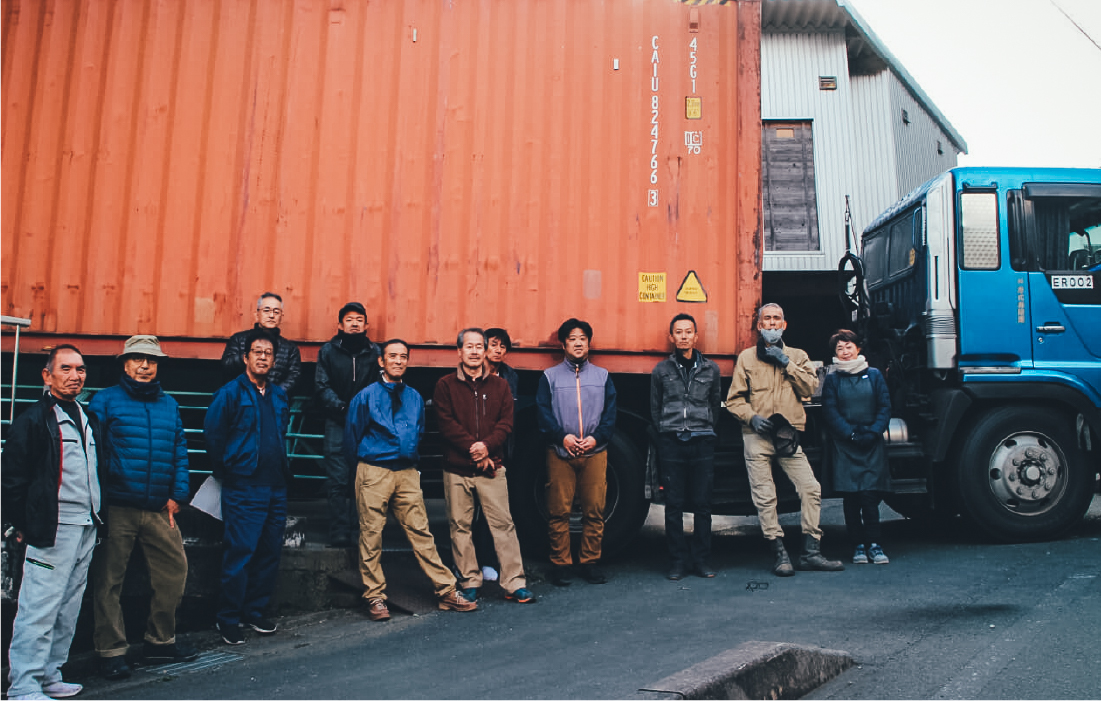
In mid-December 2020, the kominka – which we have come to refer to as Mikawa House – and shoji, ranma, tansu, tokomoma, and many other treasures were carefully packed in thirteen wooden cartons. On December 14th the cartons were loaded into a shipping container and Mikawa House left for Oregon.
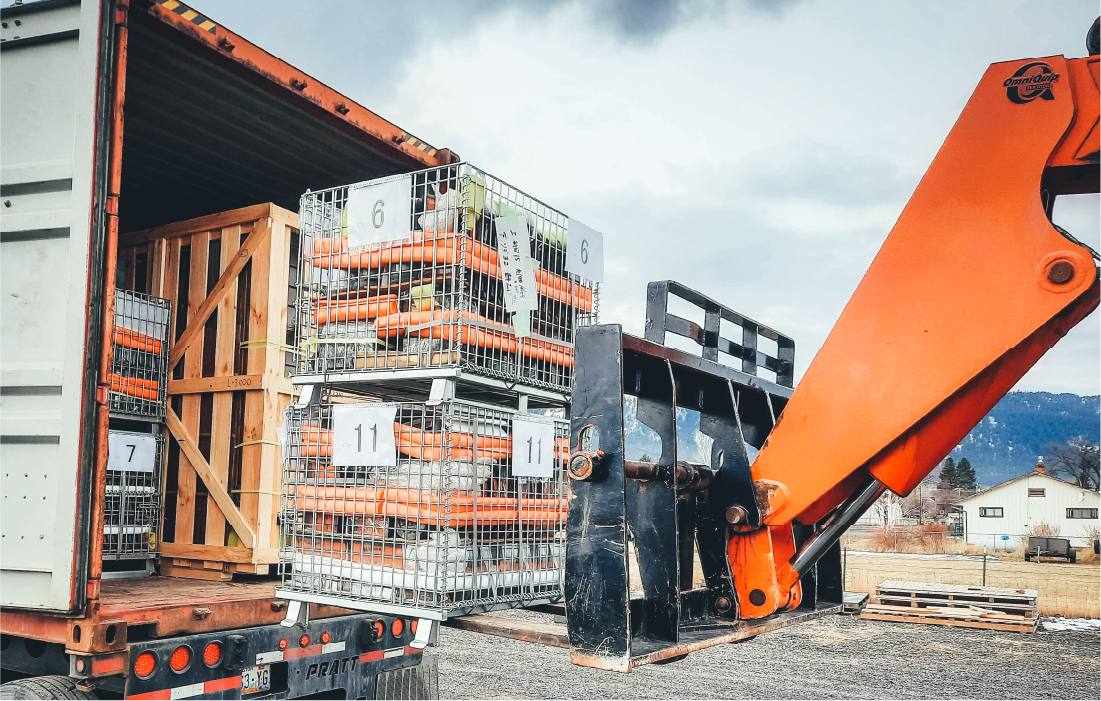
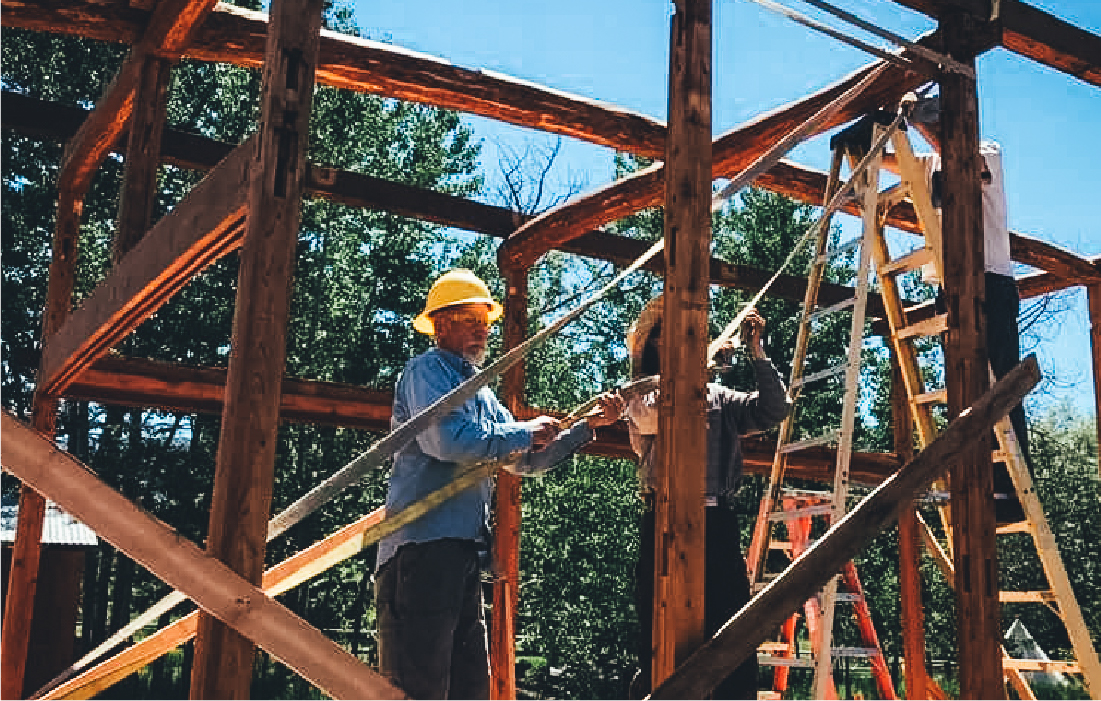
On January 9, 2021, the container arrived safely in the United States, and when the snow melted and weather allowed, the foundation and roof were built and, with the help of local carpenter friends who have an interest in Japanese timber construction, the frame was reassembled. Currently, Eric is working on the interior work and the project is steadily progressing toward completion.
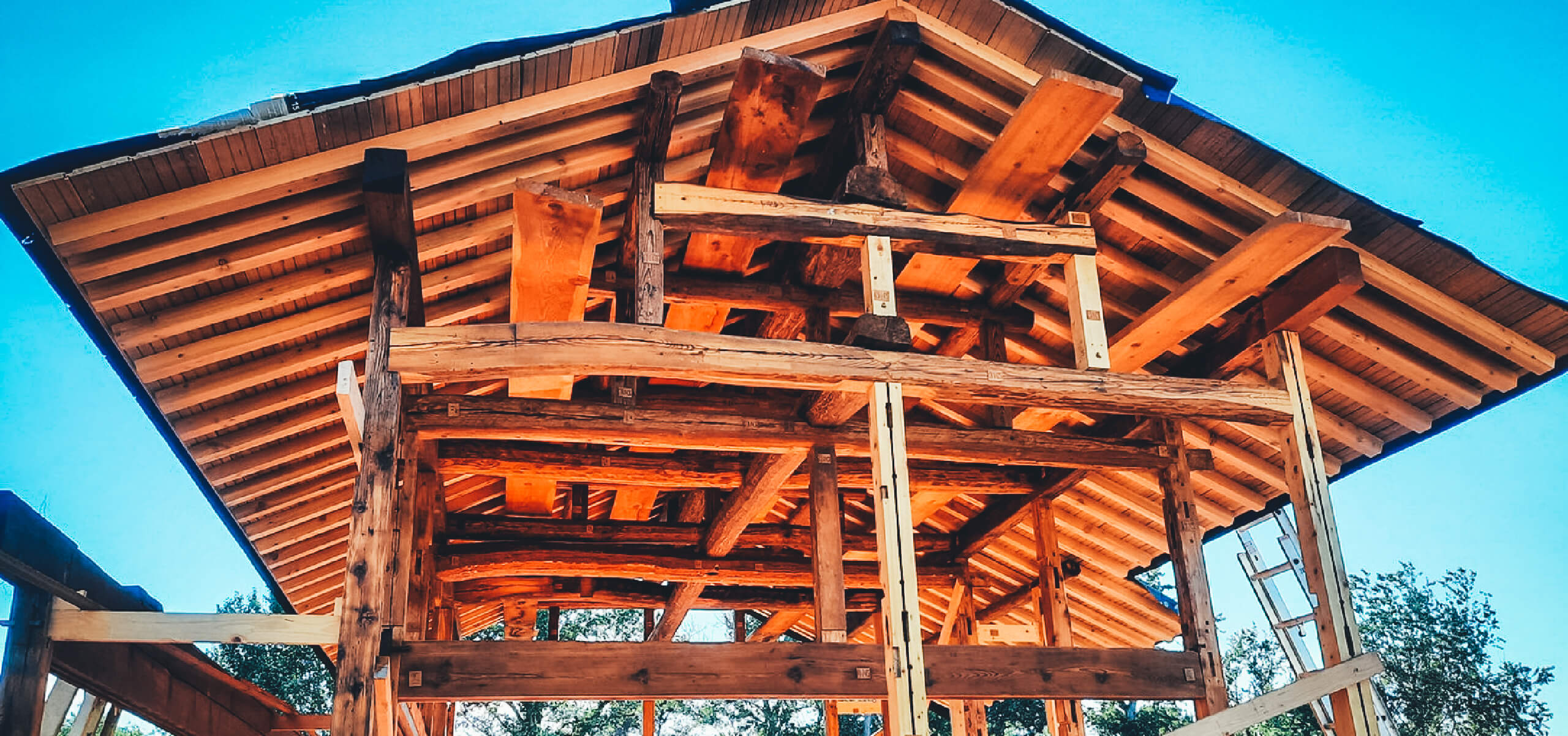
Building on this momentum, a second building relocation project is now underway. Like the first building, it is going to Eric’s property in northeast Oregon. The structure has now been assembled, and we are working to clear up some loose ends to get it ready to ship, although the import/export market is in turmoil and, due to the current shortage of shipping containers, it may be difficult to send it by the end of the year.
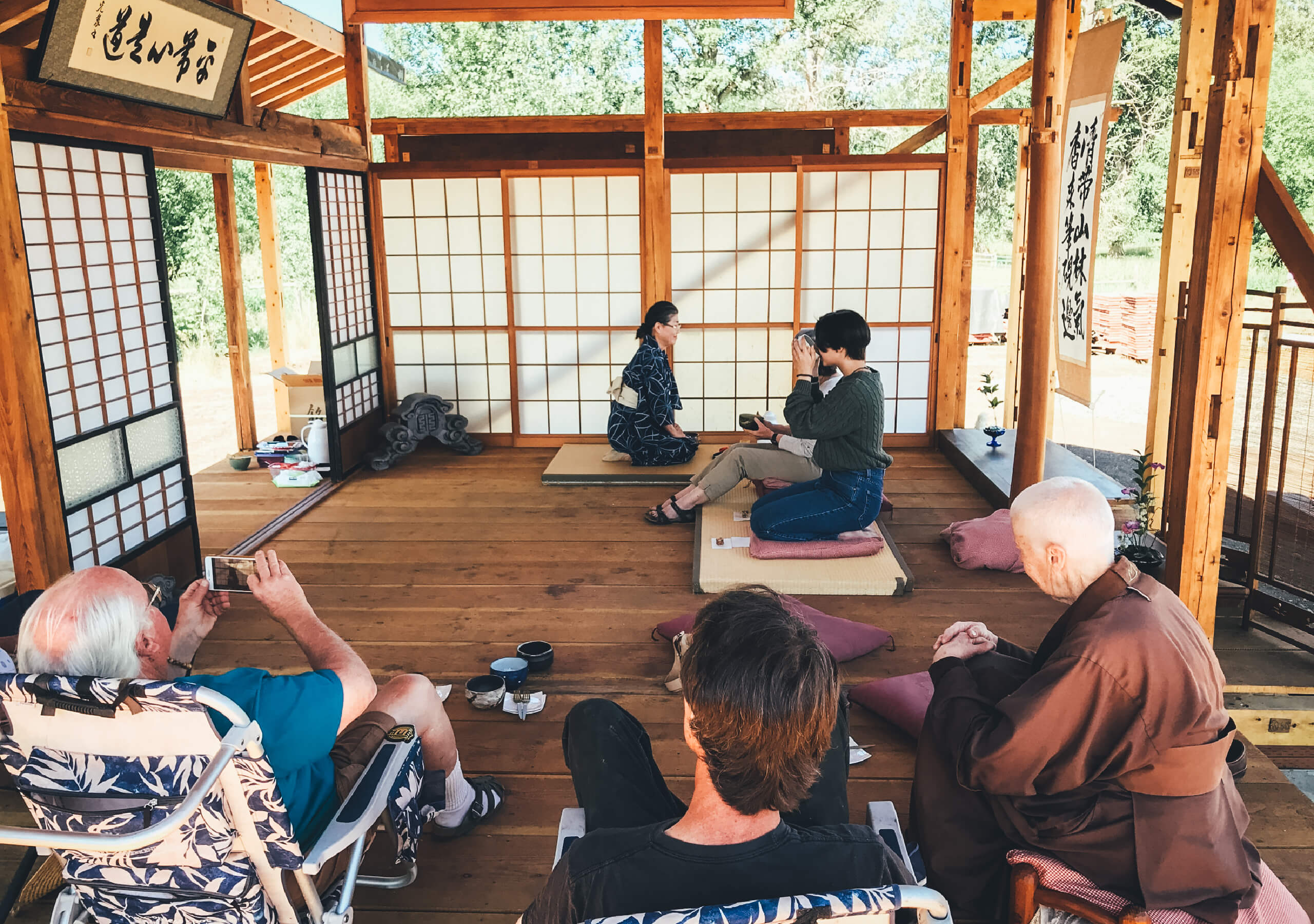
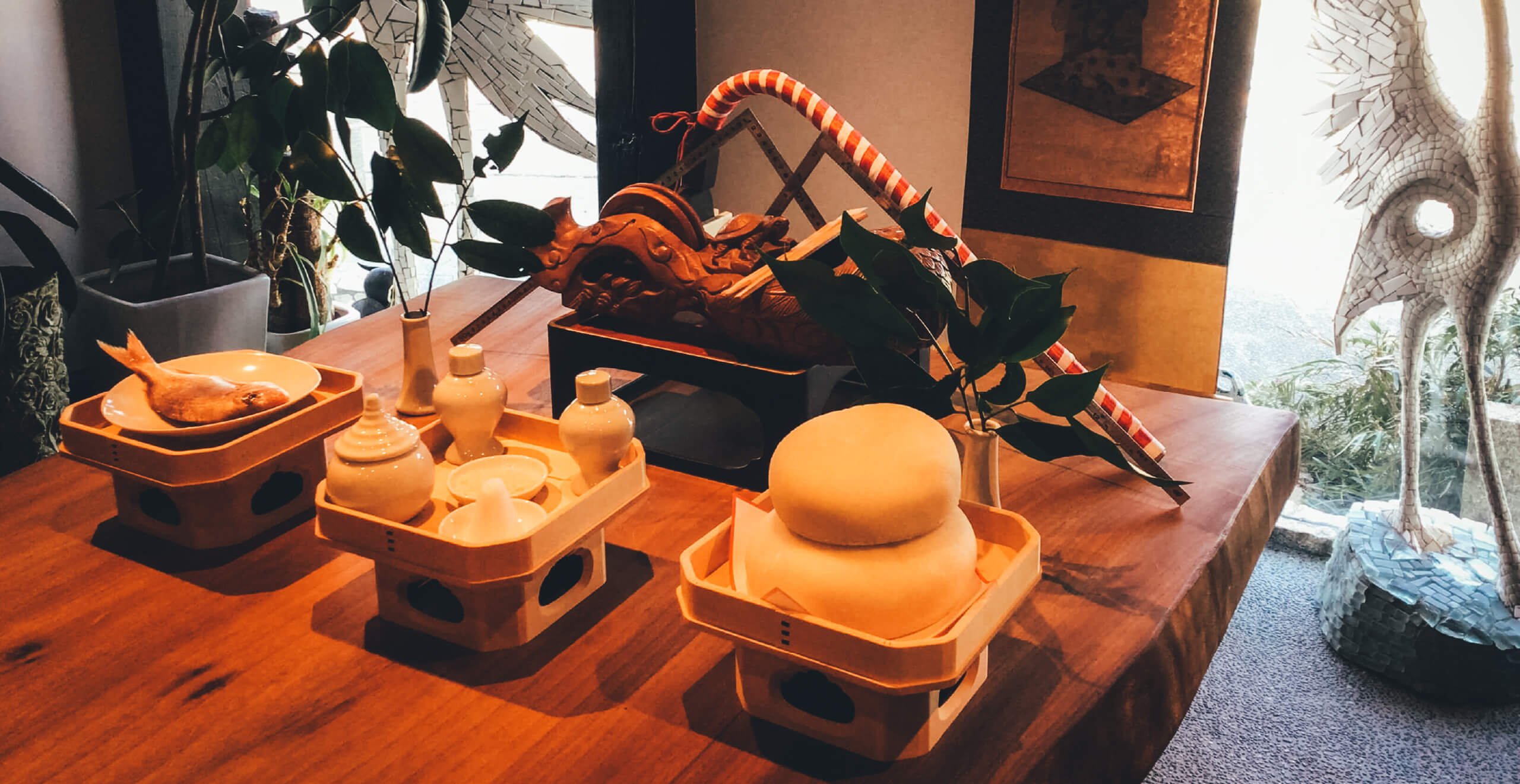
In the latter half of February, while Eric was in Japan, we invited him to participate in an event called Taishi Ko, which is a ceremony to commemorate the anniversary of the death Prince Shotoku, who brought various skills, including carpentry, to Japan from China during the 5th century.
The festival began in the Muromachi period (1333-1573), and by the Edo period (1603-1868), it had become a popular event in many parts of Japan, with carpenters, plasterers, blacksmiths, roofers, and bucket makers as the ancestors of the artisans. Prince Shotoku is said to have introduced from the continent a very important ruler for carpenters called the Sashigane, which is similar to a calculation scale and is depicted on Japanese paper currency.
The hanging scroll in the photo is a scroll of Prince Shotoku which we have inherited from our ancestors.
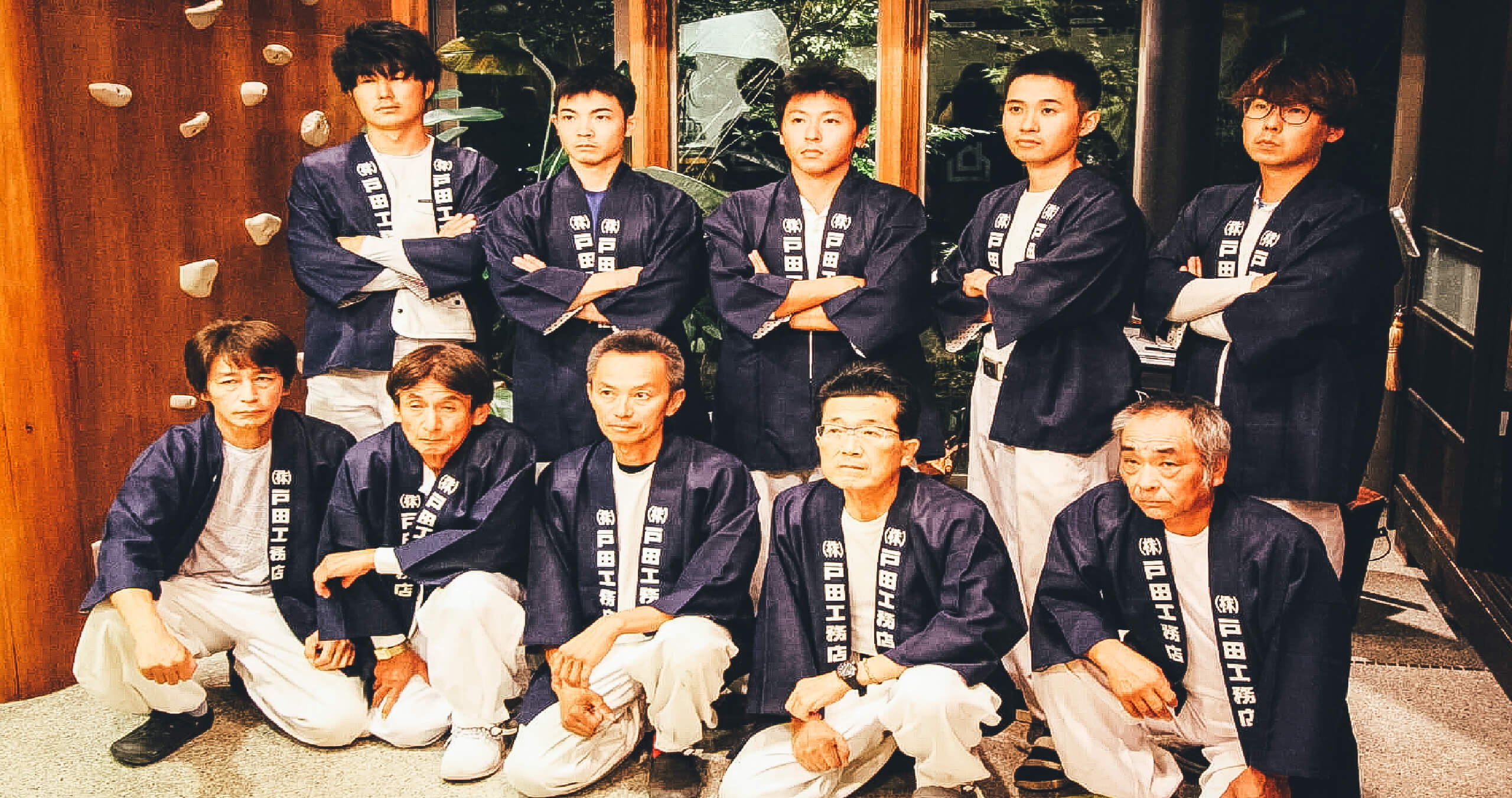
The driving force behind our work in reclaiming and reconstructing kominka is our desire to help train young carpenters and solve the problem of abandoned traditional structures. Although the two kominka being relocated to Oregon are not very large in scale, working on them covers all the skills that a carpenter needs to know, so it is easy for young carpenters to receive guidance from skilled carpenters and apply them to actual traditional carpentry work in Japan.
After the pandemic is over, we will visit the United States to interact with people who appreciate old Japanese houses and we will do what we can to contribute to the recognition of the high level of traditional Japanese carpentry skills. We hope that this will lead to better treatment of skilled carpenters in Japan.
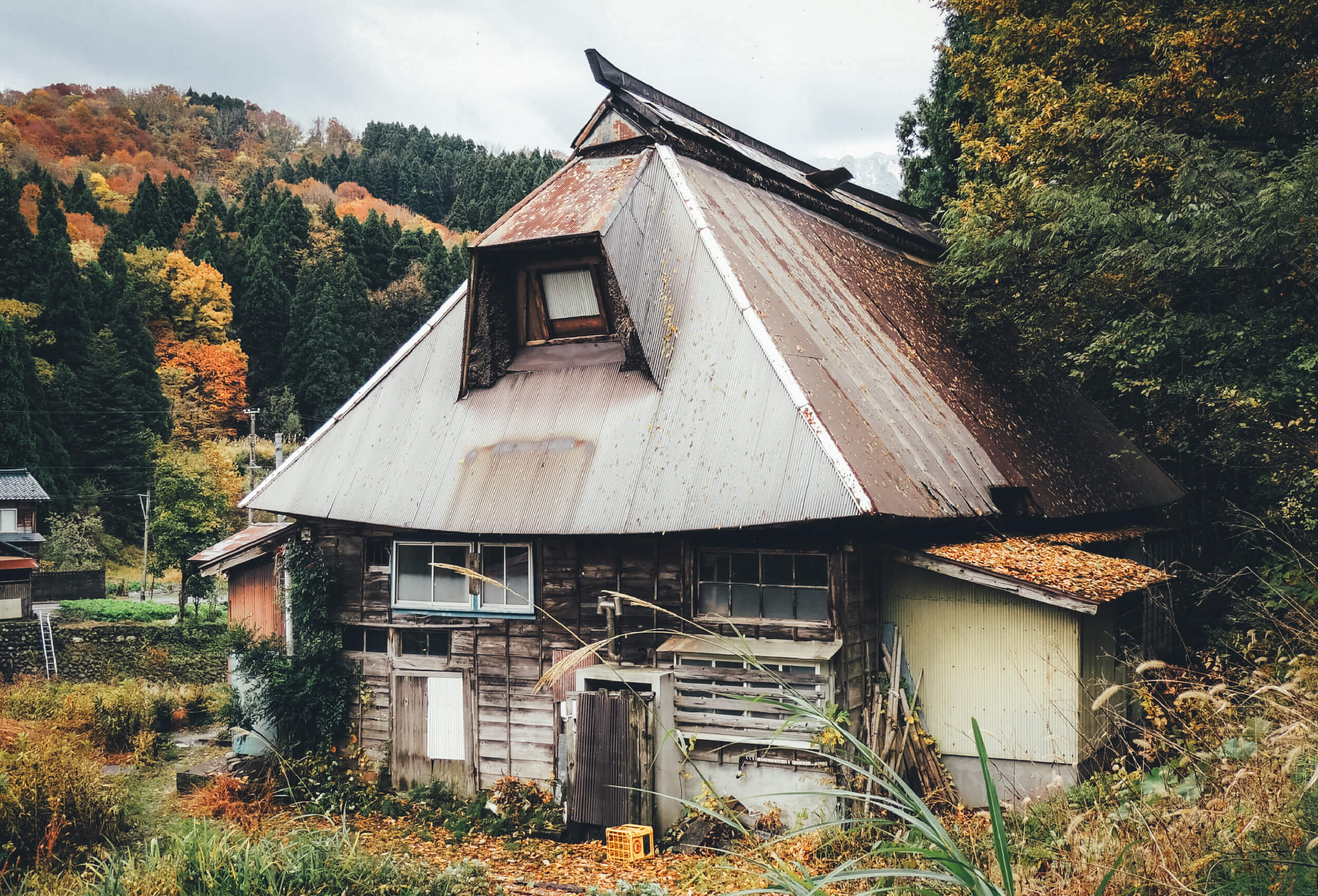
There are many old kominka in Okumikawa, and as the years go by, the percentage of vacant old houses will become larger and larger. It would be wonderful if we could find people who would make use of the kominka where they stand, but most of these rural locations have a great many things that people may find inconvenient in their modern daily lives.
“I love kominka, but living in such a remote area is just too harsh and inconvenient.”
In the course of working on the issue of vacant kominka, we cannot tell you how many times we have heard this comment from people who want to live in a kominka in the countryside, but are deterred by the lack of convenience.
When we wondered if the only way for an old house in such a remote location was to decay and return to the earth, this idea of relocation came to the rescue.
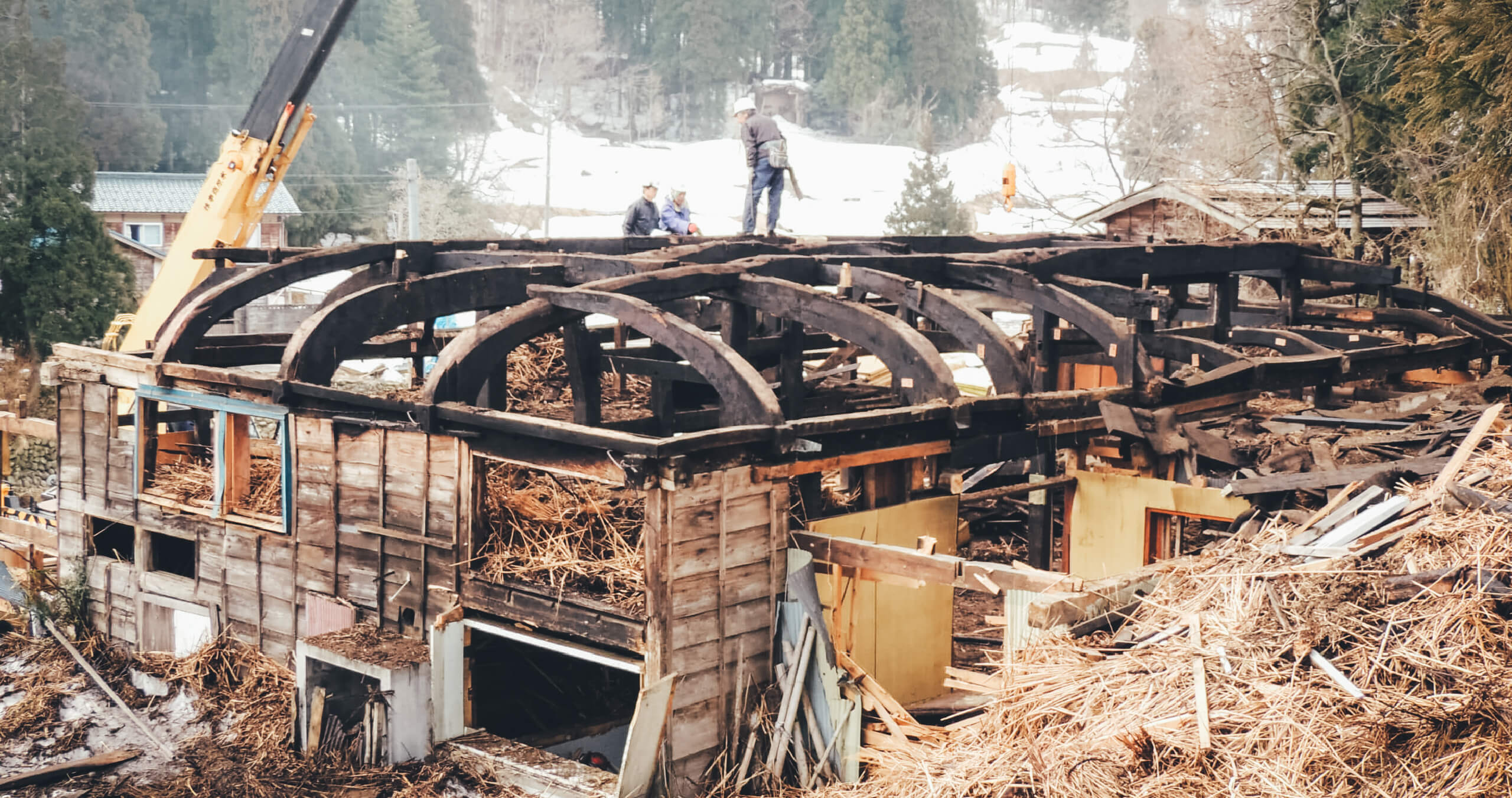
Thinking of old houses as real estate and as movable property, the idea is to deliver them to people in Japan and abroad who want them. Normally, it would be of course best for the owner of the house to live in it and maintain it but, due to various reasons, there are many cases where this is not possible, and if an old house – filled with the skills and thoughts of the carpenters of the past – that should be preserved for future generations is simply left to decay, then it may be an option to have someone who understands the value of the old house take it over. To us, this seems like a good idea.
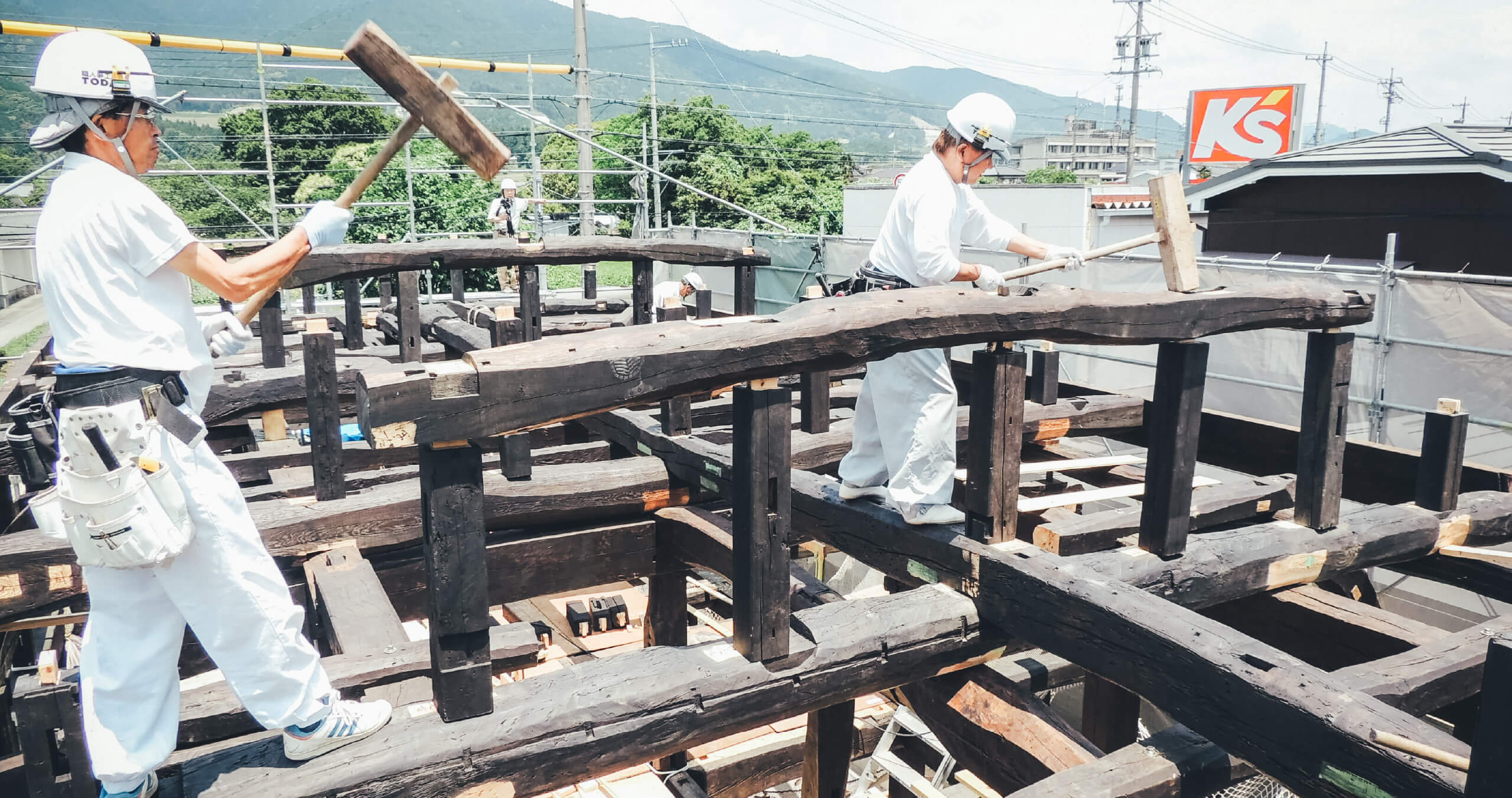
This may not be a fundamental solution to the problem of vacant kominka, but it does avoid the possibility that old houses which are left to decay will have a negative impact on the surrounding area or that they will be forcibly demolished using government money, which is our tax money.
We have a number of things to think about, but rather than stand still, we are going to take action. With good luck, we may meet someone who also loves kominka and would like to relocate one to another country. We think such activities are one way, however small, we can repay the kindness Okumikawa has shown us and honor our roots.
As a small company, we are limited in what we can do and in the scope of what we can do, but we will continue to do what we can to protect the carpenters, the community, the old folk houses, and the mountains so that the next generation will be able to do the same.